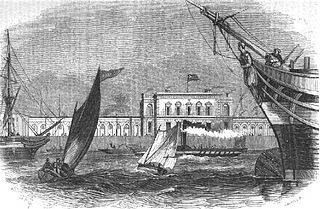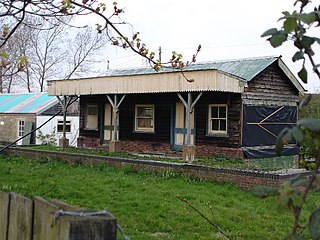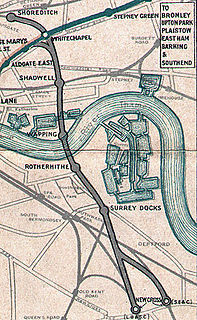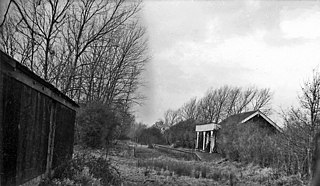Related Research Articles

Blackwall was a railway station in Blackwall, London, that served as the eastern terminus of the Commercial Railway. It was located on the south side of the East India Docks, near the shore of the River Thames, 3 miles 43 chains (5.7 km) down-line from the western terminus at Fenchurch Street.

Knowlton was an eccesiastical and civil parish; the former was abolished in 1940, the latter in 1935, and the hamlet is now part of Goodnestone civil parish. It is located about 10 miles (16 km) north of Dover in Kent, England. Knowlton Hall, set in 200 acres (81 ha) of parkland, is located here.

High Halden Road is a disused railway station on the defunct Kent and East Sussex Railway which closed in 1954. The station building and platform still survives as farm offices beside the A262 road.

Cranbrook railway station is a disused English station which was on the closed Hawkhurst Branch in Kent, England.

Eythorne railway station is a station on the East Kent Railway. Originally a station on the East Kent Light Railway, It opened on 16 October 1916 but closed to passenger traffic after the last train on 30 October 1948. It served as the junction for the branch to Guilford Colliery, which was abandoned in 1921. The track on this branch was lifted in 1931 but relaid during World War II to accommodate a 9.2 inches (230 mm) rail mounted gun. The station served the village of Eythorne, it reopened as part of the East Kent Railway in 1993.

Tilmanstone Colliery Halt was a station on the East Kent Light Railway. It opened on 16 October 1916 and was renamed Elvington in 1925. It closed to passenger traffic after the last train on 30 October 1948. The station served the pit village of Elvington. Part of the platform is still in situ hidden in undergrowth.
Eastry South railway station was a railway station on the East Kent Light Railway. It opened on 13 April 1925 and closed to passenger traffic after the last train on 30 October 1948. The station served the village of Eastry. There was a siding to the south of the station. The track was removed in May 1954.

Eastry railway station was a railway station on the East Kent Light Railway. It opened on 16 October 1916 and closed to passenger traffic after the last train on 30 October 1948. It was the station before the Richborough Branch diverged from the main line to Wingham. The station served the village of Eastry, it had a passing loop, but this had been converted to a siding in 1948. The track was removed in May 1954. There is no trace of the station today as the area has been landscaped into fields.
Woodnesborough railway station was a railway station on the East Kent Light Railway. It opened on 16 October 1916 and closed to passenger traffic after the last train on 30 October 1948. The station served the village of Woodnesborough. There was a 500-gallon water tank and a siding. A half mile long branch served Hammill Brick Works, built on the site of the aborted Hammill Colliery. Today the station site is now covered by industrial buildings.
Staple railway station was a station on the East Kent Light Railway in southeast England, serving the village of Staple. It was located north of the village, on the west side of the road to Durlock, where it crosses over the Wingham River at Durlock Bridge.
Wingham Colliery railway station was a railway station on the East Kent Light Railway in southeast England. It was intended to serve Wingham Colliery, a short distance to the south, but the mine was aborted without producing any coal. The railway then tried to develop a passenger business, extending the line towards Wingham Town with the long-term aim of reaching Canterbury, but ran out of money before they did so.
Wingham Town railway station was a railway station on the East Kent Light Railway, which served the village of Wingham. It opened in 1920 and closed to passenger traffic after the last train on 30 October 1948. There was a loop when the station first opened, but this was removed when the line was extended to the Canterbury Road station in 1925. Today the site of the station is occupied by a row of private garages and the village Scout Hut.

Wingham railway station was a terminus on the East Kent Light Railway. It opened in 1925 and the last passenger train ran on 30 October 1948. There was a siding to the south of the road, and carriages were usually run into the station under gravity. Occasional freight/parcel trains ran until 1950 but the station was not officially closed until 1951. After closure the cutting containing the station was infilled and covered with a field of crops. The site of the sidings are now occupied by a tea shop adjacent to which is a short section of undisturbed trackbed.

Ash Town railway station was a railway station on the East Kent Light Railway. The station served the village of Ash.
Poison Cross railway station was a railway station on the East Kent Light Railway. It opened in November 1925 and closed to passenger traffic on 1 November 1928. There was a passing loop and a siding.
Roman Road railway station was a railway station on the East Kent Light Railway. It opened in November 1925 and closed to passenger traffic on 1 November 1928. Today there is no trace of the station.

Old Kent Road was a railway station on the London, Brighton and South Coast Railway line in south London. It took its name from the Old Kent Road on which it was located.

Frittenden Road was a railway station on the Kent and East Sussex Railway which closed in 1954. The wooden station building lay derelict for years and was destroyed by fire in October 2003.

Biddenden was a railway station on the Kent and East Sussex Railway which closed in 1954.

Tenterden St. Michael's was a railway station on the Kent and East Sussex Railway which served the Tenterden suburb of St Michaels in Kent, England. The station was situated on the southern side of a level crossing to the south of St. Michael's tunnel, one of the line's main civil engineering features. Closed in 1954, nothing remains of St. Michael's today: a footpath and cycleway runs through the site.
References
- ↑ "Disused Stations: Knowlton Halt".
- ↑ Vic Mitchell, Keith Smith (1989). The East Kent Light Railway. Midhurst, Sussex, UK: Middleton Press. ISBN 0-906520-61-4.